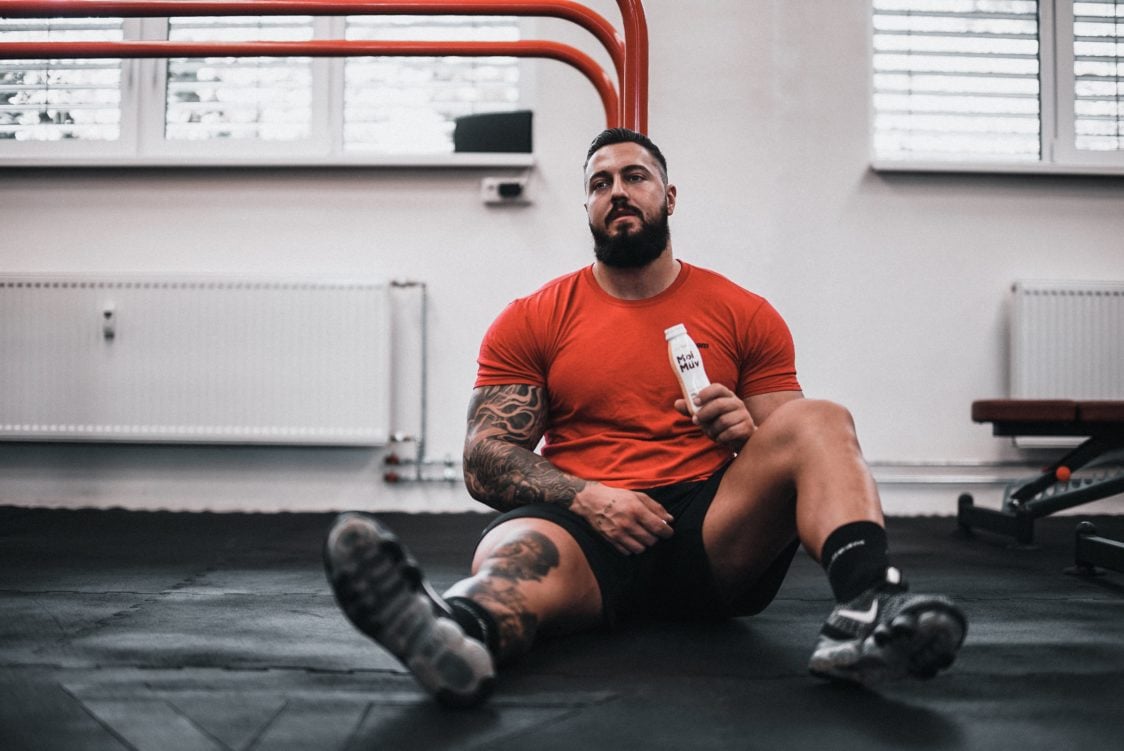Table of Contents
Recently in workouts, “hi-tech“ has spread in which people control their heart rate, calories burned and a bunch of other values. The question is whether monitoring your heart rate during training is necessary, interesting or completely irrelevant. Learn all the essentials in the article about heart rate and its importance during exercise.
What is heart rate?
Heart rate is basically the frequency of heartbeat. In addition to the term heart rate, the term pulse is also used, but both terms express the number of heartbeats per minute. Its pace changes depending on whether we are sitting in front of the TV or running on a treadmill. The higher the intensity of the activity, the higher the frequency value. [3]
You can easily measure your heart rate by placing your index finger and middle finger on your neck. More precisely on the side of the neck, to feel the pulse of the trachea. Do you want the second variant? Another option is to measure on your wrist. Again, you need to put your finger, but this time between the bone and the tendon on your wrist towards your thumb. Have you felt your pulse? At this point, look at your watch and count the number of beats in 15 seconds. Multiply the result by four and you have a heart rate per minute. [4]

In order to be able to assess the intensity of the training with respect to the heart rate, we should start with the value that we will need first. It is called the maximum heart rate and refers to the highest rate your heart can reach in a minute. You can calculate your maximum heart rate using a simple mathematical formula [1] [5]:
207 – (0,7 x your age) = maximal heart rate
In addition to this formula, you may also come across a variant to calculate the approximate maximum heart rate by simply subtracting your age from 220. As you can now correctly guess, the rate value changes during life, more precisely decreases. If you are interested in what your frequency will be after 5, 10, or 20 years, compare your current state with the possible future in the table [2]:
| AGE | HEART RATE 50 – 85% | MAXIMUM HEART RATE – 100% |
|---|---|---|
| 20 years | 100 – 170 BPM (beats per minute) | 200 BPM |
| 30 years | 95 – 162 BPM | 190 BPM |
| 35 years | 93 – 157 BPM | 185 BPM |
| 40 years | 90 – 153 BPM | 180 BPM |
| 45 years | 88 – 149 BPM | 175 BPM |
| 50 years | 85 – 145 BPM | 170 BPM |
| 55 years | 83 – 140 BPM | 165 BPM |
| 60 years | 80 – 136 BPM | 160 BPM |
| 65 years | 78 – 132 BPM | 155 BPM |
| 70 years | 75 – 128 BPM | 150 BPM |
Pulse during exercise – heart rate zones
As we have already mentioned, the higher the intensity of the training, the higher the number of heartbeats. Based on your pulse, you can deduce how demanding your activity is. There are 5 different zones that express the level of heart activity as a percentage of the maximum heart frequency (MSF). These are the 5 zones [1] [6] [7]:
- zone – “Very easy” – 50 – 60% MSF
- activity with the lowest intensity that is suitable for regeneration
- is great for the warm-up and cool down part of training
- staying at this level shouldn’t be a problem for you for a few hours
- zone – “easy” – 60 – 70% MSF
- is given for running within 90 minutes
- it is possible to have a normal conversation during this zone
- supports the body’s ability to use fat as a source of energy
- it is the pace at which e.g. marathon runners run
- long-distance runners (half marathon and longer) should stay in it about 80% of the total running time

- zone – “medium” – 70 – 80% MSF
- you can stay in it for about 30 minutes
- is referred to as the aerobic zone
- it is suitable for improving blood circulation in skeletal muscles and heart
- is great for improving aerobic capacity and endurance
- Oxygen is used as energy for the cells
- lactic acid begins to accumulate in the bloodstream
- zone – “difficult” – 80 – 90% MSF
- you should stay in it for about 10 minutes
- it uses a combination of aerobic and anaerobic metabolism
- above 84% of MSF the body undergoes anaerobic metabolism
- is great for raising lactic acid threshold and performance
- contributes to the management of higher levels of lactic acid in the blood
- supports the body’s ability to use carbohydrates as a source of energy

- zone – “very difficult” 90% – 100% MSF
- the highest and maximum training intensity
- you can stay in it for a maximum of 2 minutes (according to another source for 5 minutes)
You might be interested in these products:
Why is it important to know your heart rate during exercise?
Do you exercise, but sometimes you feel that your pulse is too high or are you worried that your heart rate is too low? It is the heart rate that can be an indicator of the level of activity. However, it all depends on your goals and type of training. An example is the difference between 5-kilometer training and a marathon. In the case of a long track, such as a marathon run, it is important to maintain a steady pace over long kilometers. Runners should stay in the 1st and 2nd zones for a significant part (about half) of the training during this type of training. For runners with training focused on 5 kilometers, it is beneficial to improve the run more often to the 3rd and 4th zones. You must have noticed that the intensity of running for marathon runners is lower than when running at lower distances. [8] [9]
If you are training for progress, you should be interested in the number of heartbeats per minute, because you will notice an improvement thanks to it. Trained athletes have a “resting” pulse of about 40 beats per minute. If you start training and want to know your personal improvement, try to also write down your heart rate at rest. Exercise will strengthen your heart and lungs, but most importantly, number of you heart beats will start to decrease. [10]
Pulse control is also useful to prevent overtraining. Thanks to this, you will not get “beyond the limit” by training, therefore you will avoid emotional fatigue and also possible injuries. [10]

Knowing your pulse is not a condition during training. However, it has several advantages. If you run regularly and add a “daily number of steps”, you don’t have to measure your heart rate precisely. If you have fitness goals, and you are interested in controlling the improvement in performance, we definitely recommend measuring your heart rate. As we mentioned, knowing your heart rate will also prevent injuries and overtraining. Last but not least, make sure that you do not go “under” the aerobic zone.
What has an effect on heart rate?
As we have already mentioned, the pulse of an adult at rest is 60-100 beats per minute. In addition to age, heart rate is affected by several factors, including [3] [4]:
- physical condition and activity
- health condition – cardiovascular diseases, diabetes and high cholesterol
- medicine
- body size – obese people tend to have a higher heart rate
- body position – the value of the pulse when laying is lower than when standing
- smoking and coffee – caffeine and nicotine affect the heart rate, this also applies to tea and soda
- emotional state – anxiety and stress increase the pulse
Problem heart rhythm
An abnormal heart rhythm is considered to be an irregular, too low, but also too high heart rate. The normal pulse for an adult at rest is from 60 to 100 beats per minute. The problem starts if the number is different. [11]
- Low blood pressure (bradycardia) – the heart rate at rest is too slow, more precisely less than 60 beats. Exceptions are athletes, their slower heart rate is not the result of disease, but on the contrary, their fitness.
- High pressure (tachycardia) – has several types and represents over 100 strokes per minute.
- Heart arrhythmias – may or may not have symptoms. However, they may manifest as palpitations or pain and tremor. The important thing is that not all of them are threatening, but it is definitely better to tell your doctor about them.
Athletes and heart rate
As already mentioned, athletes may have a lower heart rate at rest. This is due to training, because it not only trains muscles, but also the heart, thanks to which it can pump more blood. However, you are certainly interested in how you will recognize that athlete’s heart rate is too low or dangerously high.
Low heart rate in athletes is often considered to be only a condition that has other symptoms, such as weakness, fatigue and dizziness. An excessive heart rate is considered if you exercise more intensely than at maximum heart frequency for a longer time. This is a dangerous condition, and it is better to stop, for example, in case of dizziness. [12]
Having the right pulse is necessary not only in life to maintain health. It also makes sense to monitor the heart rate during exercise to prevent overtraining and injury, but also to achieve the desired effect of training. We hope you have learned all the important things about the benefits of heart rate control, heart rate zones, but also what influences the right heart rate. Do you want your friends to know about the pulse and the effect of its control during training? Feel free to support the article by sharing.
[1] Allie Flinn – Is It Really That Important to Know Your Heart Rate During a Workout? – https://greatist.com/fitness/heart-rate-zones
[2] Target Heart Rates Chart – https://www.heart.org/en/healthy-living/fitness/fitness-basics/target-heart-rates
[3] Your Heart Rate – https://www.webmd.com/heart-disease/heart-failure/watching-rate-monitor#1
[4] Edward R. Laskowski, M.D. – What’s a normal resting heart rate? – https://www.mayoclinic.org/healthy-lifestyle/fitness/expert-answers/heart-rate/faq-20057979
[5] Paige Waehner – Understanding Your Maximum Heart Rate – https://www.verywellfit.com/maximum-heart-rate-1231221
[6] ASHLEY MATEO – Heart Rate Training Can Make You Faster—Here’s How – https://www.runnersworld.com/beginner/a20812270/should-i-do-heart-rate-training/
[7] HEART RATE ZONES | THE BASICS – https://www.polar.com/blog/running-heart-rate-zones-basics/
[8] Jane Chertoff – What’s My Ideal Running Heart Rate? – https://www.healthline.com/health/running-heart-rate
[9] WHY IS IT IMPORTANT TO MONITOR YOUR HEART RATE DURING EXERCISE? – https://support.polar.com/en/support/Why_is_it_important_to_monitor_your_heart_rate_during_exercise_
[10] Why is it important to monitor your heart rate? – https://sport360.com/article/health-and-fitness/230407/why-is-it-important-to-monitor-your-heart-rate
[11] Brindles Lee Macon – What You Need to Know About Abnormal Heart Rhythms – https://www.healthline.com/health/abnormal-heart-rhythms
[12] Jane Chertoff – Why Do Athletes Have a Lower Resting Heart Rate? – https://www.healthline.com/health/athlete-heart-rate


Add a comment